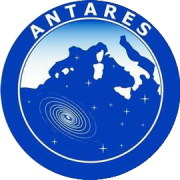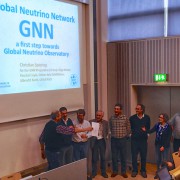ANTARES, NEMO, NESTOR
ANTARES was the first operational neutrino telescope in the Mediterranean Sea and a pilot project for KM3NeT. It was located close to the KM3NeT-Fr site, offshore Toulon, France. Since its completion in 2008, the telescope has continuously taken data during 14 years until its decommissioning in 2022. The ANTARES collaboration has published and is still publishing many results in peer reviewed scientific papers and at international conferences. Major partners in the ANTARES Collaboration formed the KM3NeT Collaboration.
Two other pilot projects preceding the design of the KM3NeT Research Infrastructure were NEMO, off-shore Sicily, Italy and NESTOR off-shore Pylos, Greece. The KM3NeT-It is located at the former NEMO site. The former NESTOR site is considered for KM3NeT-Gr.
IceCube and Baikal-GVD
KM3NeT is one of the three operational very large volume neutrino telescopes in the world, along with the Baikal-GVD and IceCube observatories, also conducted by international scientific collaborations. All three operate in different environmental conditions and at different geographical locations, allowing a complementary approach across the globe:
- The Baikal deep underwater neutrino telescope (or Baikal-GVD – Gigaton Volume Detector) was launched in 2015 and installed in the depths of the freshwater lake Baikal in Russia.
- The IceCube neutrino observatory was constructed in 2004-2010 in the ice of the South Pole, in the Antarctic.
- A new initiative is the path finder project P-ONE in the Pacific Ocean offshore the Canadian coast.
Global Neutrino Network
KM3NeT is one of the founding partners of the Global Neutrino Network (GNN) that aims for a closer collaboration and a coherent strategy planning among the neutrino telescope projects.
At present, GNN consists of the ANTARES, Baikal-GVD, IceCube and KM3NeT Collaborations.
GNN aims to develop a coherent strategy and to exploit the synergistic effects of cooperation. It serves as a forum for formalising and further developing the present annual Mediterranean-Antarctic Neutrino Telescope Symposium (MANTS) meetings and the biannual international workshop on Very Large Volume Neutrino Telescopes (VLVNT). Goals of GNN include the coordination of alert and multi-messenger policies, exchange and mutual checks of software, creation of a common software pool, establishing a common legacy of public documents, developing standards for data representation, cross-checks of results with different systematics, the organisation of schools, and other forms of exchanging expertise, e.g. through mutual working visits of scientists and engineers or by forming ad-hoc advisory committees of members of the four participating collaborations.
European Multidisciplinary Seafloor and water column Observatory
EMSO is a large-scale European Research Infrastructure in the field of environmental sciences. EMSO is based on a European-scale distributed research infrastructure of seafloor and water column observatories; with the basic scientific objective of long-term monitoring, mainly in real-time, of environmental processes related to the interaction between the geosphere, biosphere, and hydrosphere, including natural hazards. It is composed of several deep-seafloor observatories and shallow water test sites, which will be deployed on specific sites around European waters, reaching from the Arctic to the Black Sea passing through the Mediterranean Sea, thus forming a widely distributed pan-European infrastructure.



